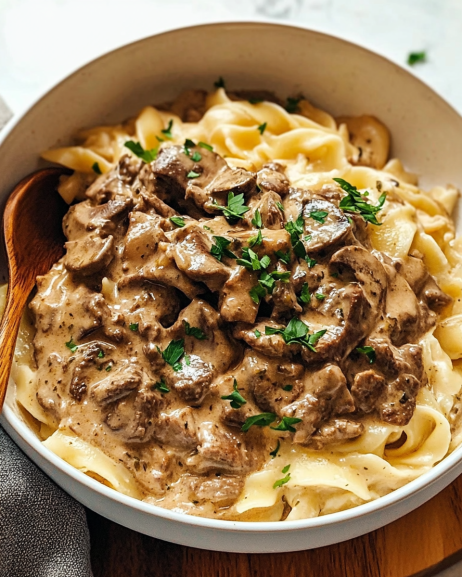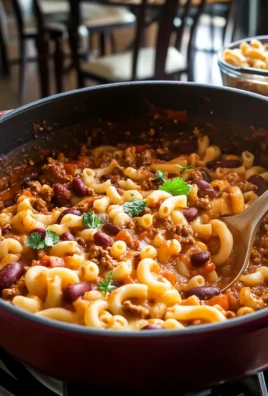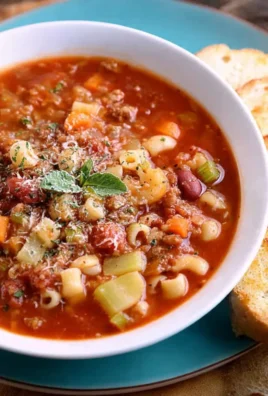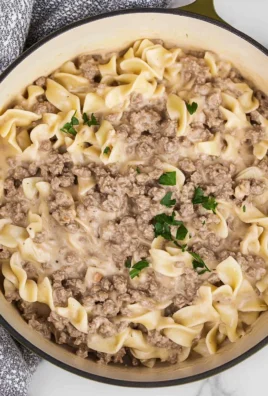
Beef Stroganoff is a globally cherished dish that has graced dinner tables for centuries. Its rich, creamy sauce, tender strips of beef, and earthy mushrooms create a harmonious blend of flavors that is both indulgent and comforting. Known for its versatility, Beef Stroganoff can be adapted to various ingredients, serving styles, and occasions. Whether prepared as a weeknight meal or a centerpiece for a formal gathering, this dish consistently delivers satisfaction.
Overview of Beef Stroganoff
At its core, Beef Stroganoff is a combination of sautéed beef, a savory mushroom-onion base, and a luxurious sour cream sauce. Traditionally served over egg noodles, rice, or mashed potatoes, it’s a hearty dish that offers a balanced combination of protein, carbohydrates, and fat. The origins of Beef Stroganoff are deeply rooted in Russian cuisine, but the recipe has evolved over time to incorporate regional twists and ingredient substitutions, making it a true culinary classic.
Brief History and Cultural Significance
The origins of Beef Stroganoff can be traced back to mid-19th century Russia, where it was first documented in a cookbook by Elena Molokhovets. The dish is believed to have been created for Count Pavel Stroganov, a member of a wealthy and influential family. The combination of French culinary techniques and Russian ingredients reflects the cultural exchange that defined the Russian aristocracy at the time.
In its original form, Stroganoff featured sautéed beef cubes in a simple mustard and sour cream sauce. Over the years, additional ingredients like onions, mushrooms, and paprika were added, and the dish became a staple of Russian cuisine. Its popularity spread across Europe, where chefs introduced variations with different meats, spices, and serving styles. During the mid-20th century, Beef Stroganoff gained international acclaim, becoming a beloved dish in the United States, particularly during the mid-century era of elaborate dinner parties.
Today, Beef Stroganoff represents comfort and tradition. It has been adapted to suit various dietary preferences, making it a versatile dish with endless possibilities.
Ingredients
The success of Beef Stroganoff lies in the quality and balance of its ingredients. Each component contributes to the dish’s signature flavor and texture, creating a cohesive and satisfying experience.
- Beef
- Traditionally, tender cuts like sirloin, tenderloin, or ribeye are used. These cuts ensure the beef remains juicy and flavorful, even with quick cooking.
- Alternative cuts, such as flank steak or chuck roast, can be used but may require marination or longer cooking times.
- Mushrooms
- Mushrooms are a key ingredient, adding a deep, earthy flavor. White button mushrooms or cremini mushrooms are commonly used, but wild mushrooms like chanterelles or porcini can elevate the dish further.
- Onions
- Finely chopped onions form the aromatic base of the sauce, contributing sweetness and depth. Yellow onions are traditional, but shallots can be used for a more delicate flavor.
- Garlic
- Minced garlic enhances the overall flavor with its pungent and savory notes.
- Beef Broth
- A rich beef broth is used to deglaze the pan and forms the foundation of the sauce. For added depth, consider using homemade stock or bone broth.
- Sour Cream
- Sour cream adds creaminess and a tangy element that balances the richness of the beef and mushrooms.
- Greek yogurt or crème fraîche can be substituted for a lighter or more gourmet twist.
- Mustard
- Dijon mustard is often included for a sharp, slightly acidic flavor that cuts through the richness of the sauce.
- Flour or Cornstarch
- Used as a thickening agent to achieve the desired sauce consistency.
- Butter and Oil
- A combination of butter and oil is used for sautéing, providing flavor while preventing burning.
- Seasonings
- Classic seasonings include salt, black pepper, and paprika. Smoked paprika can be added for a subtle smokiness, while a pinch of nutmeg enhances the creamy elements.
Preparation Tools and Their Importance
- Large Skillet or Sauté Pan
- A wide skillet provides ample surface area for browning the beef and cooking the sauce evenly. A heavy-bottomed pan is ideal for retaining heat.
- Sharp Knife
- A sharp knife is essential for slicing the beef into thin, uniform strips. Proper cutting ensures even cooking and tender results.
- Cutting Board
- A sturdy cutting board makes ingredient preparation more efficient and safe.
- Mixing Bowl
- Used for tossing the beef with seasonings before cooking.
- Wooden Spoon or Silicone Spatula
- Ideal for stirring and scraping the pan to incorporate browned bits into the sauce.
- Whisk
- Ensures a lump-free sauce when incorporating flour or cornstarch.
- Measuring Cups and Spoons
- Precise measurements ensure the perfect balance of ingredients in the sauce.
- Serving Dish
- A large, shallow serving dish showcases the finished Stroganoff and makes it easy to portion out.
Preparation Steps
- Prepare the Ingredients
- Slice the beef into thin strips, cutting against the grain to ensure tenderness.
- Clean and slice the mushrooms evenly. Dice the onions finely and mince the garlic.
- Season the Beef
- Toss the beef strips with salt, pepper, and paprika. Let them rest for a few minutes to absorb the seasoning.
- Sear the Beef
- Heat butter and oil in a large skillet over medium-high heat. Add the beef in batches to avoid overcrowding, cooking until browned on all sides. Remove and set aside.
- Cook the Aromatics
- In the same skillet, sauté the onions until softened and translucent. Add the garlic and cook for an additional minute until fragrant.
- Sauté the Mushrooms
- Add the mushrooms to the skillet and cook until they release their moisture and develop a golden-brown color.
- Deglaze the Pan
- Pour in the beef broth, scraping the bottom of the skillet to incorporate any browned bits. Bring the mixture to a simmer.
- Thicken the Sauce
- Sprinkle flour or cornstarch over the sautéed ingredients, stirring constantly to avoid lumps. Gradually add more broth if the sauce becomes too thick.
- Incorporate Sour Cream and Mustard
- Lower the heat and stir in the sour cream and mustard. Mix well to create a smooth, creamy sauce. Avoid boiling the mixture to prevent curdling.
- Combine the Beef with the Sauce
- Return the seared beef to the skillet, stirring to coat the strips evenly in the sauce. Simmer for 5–7 minutes until the beef is heated through and tender.
- Serve and Garnish
- Serve the Stroganoff over egg noodles, rice, or mashed potatoes. Garnish with fresh parsley or dill for added flavor and color.
Advanced Techniques and Variations
Once you’ve mastered the basic preparation of Beef Stroganoff, there are countless ways to elevate the dish with advanced techniques, flavor variations, and creative serving options. Whether you’re aiming for gourmet refinement or catering to specific dietary needs, these enhancements will take your Stroganoff to the next level.
1. Flavor Variations
Wine or Brandy for Depth
- Deglaze the pan with a splash of dry white wine or brandy before adding the broth.
- Alcohol enhances the overall complexity of the sauce, adding subtle fruity and nutty undertones. Ensure you let it cook down to remove the harshness of the alcohol.
Herb-Infused Sauce
- Add a bouquet garni (a bundle of fresh herbs like thyme, parsley, and bay leaves) to the sauce while it simmers.
- Alternatively, stir in chopped fresh dill or chives just before serving for a burst of brightness.
Spice It Up
- Add a pinch of cayenne pepper or crushed red pepper flakes to give the dish a gentle heat.
- For a smoky twist, incorporate smoked paprika instead of sweet paprika.
Cheesy Touch
- Stir in a handful of grated Parmesan or Gruyère cheese to the sauce for extra richness and a creamy texture.
- Sprinkle crumbled blue cheese on top before serving for a bold and tangy variation.
Mushroom Medley
- Replace or supplement common mushrooms with wild varieties like shiitake, oyster, or porcini for a more earthy, gourmet flavor.
- Rehydrate dried mushrooms in warm broth and use the soaking liquid to enhance the sauce.
2. Protein Substitutions and Additions
Chicken or Pork Stroganoff
- Substitute the beef with thinly sliced chicken breast or pork tenderloin for a lighter alternative.
- Ensure the meat is cooked just until tender to prevent drying out.
Vegetarian or Vegan Stroganoff
- Replace beef with a combination of mushrooms, tofu, or seitan.
- Use vegetable broth, plant-based butter, and a non-dairy sour cream alternative like cashew cream or coconut yogurt.
Seafood Stroganoff
- For an unconventional twist, use large shrimp, scallops, or chunks of firm white fish.
- Add the seafood to the sauce in the final minutes of cooking to prevent overcooking.
Ground Meat Variation
- Ground beef or turkey can be used for a more casual, budget-friendly version.
- Cook the ground meat thoroughly before combining it with the sauce.
3. Sauce Enhancements
Stock Reduction for Intensity
- Simmer the beef broth until reduced by half before adding it to the sauce for a more concentrated flavor.
Cream Alternatives
- For a lighter sauce, substitute sour cream with Greek yogurt or low-fat crème fraîche.
- Add a splash of heavy cream or half-and-half for an ultra-smooth, velvety consistency.
Flavor Infusions
- Include a teaspoon of Worcestershire sauce for a savory umami boost.
- Add Dijon mustard and a touch of honey to balance tanginess and sweetness.
Vegetable Additions
- Incorporate finely diced carrots, celery, or bell peppers for added texture and flavor.
- Spinach or kale can be stirred into the sauce just before serving for a pop of color and nutrients.
4. Advanced Cooking Techniques
Sous Vide Method
- Cook the beef sous vide at 130°F (54°C) for two hours to achieve perfectly tender and evenly cooked meat.
- Sear the meat quickly in a hot pan before incorporating it into the sauce.
Slow Cooker Stroganoff
- Combine all ingredients (except sour cream) in a slow cooker and cook on low for 6–8 hours. Stir in sour cream in the last 30 minutes.
- This method is ideal for achieving ultra-tender meat with minimal effort.
Pressure Cooker Stroganoff
- Use an Instant Pot to cook the beef and sauce under pressure for quick results.
- Sauté the onions and mushrooms using the sauté function before pressure cooking for maximum flavor.
5. Serving and Presentation
Classic Pairings
- Serve Beef Stroganoff over wide egg noodles, rice, or mashed potatoes for a traditional presentation.
- For a rustic option, consider pairing it with roasted or boiled baby potatoes.
Modern Accompaniments
- Replace noodles with cauliflower rice or zucchini noodles for a low-carb alternative.
- Serve with polenta or couscous for a unique twist.
Elegant Plating
- Arrange the beef strips neatly over a mound of pasta or rice, then drizzle the sauce over the top.
- Garnish with fresh parsley, dill, or chives for a pop of color.
Family-Style Serving
- Present the Stroganoff in a large, shallow dish or Dutch oven, allowing guests to serve themselves.
- Place complementary sides, such as a green salad or garlic bread, alongside for a complete meal.
6. Pairing Suggestions
Beverage Pairings
- Wine: A medium-bodied red wine like Pinot Noir, Merlot, or Syrah complements the dish’s creamy sauce and savory flavors.
- Beer: A malty lager or brown ale pairs well with the hearty, rich elements of Stroganoff.
- Non-Alcoholic: Serve with sparkling water infused with lemon or cucumber for a refreshing contrast.
Side Dishes
- Vegetables: Roasted Brussels sprouts, asparagus, or green beans add a crisp texture that balances the creamy sauce.
- Salads: A light arugula or mixed green salad with a tangy vinaigrette cuts through the richness of the dish.
- Bread: Serve with warm, crusty bread or garlic bread to mop up the sauce.
Dessert Pairings
- Finish the meal with a light dessert like lemon sorbet, panna cotta, or a fruit tart to cleanse the palate.
7. Leftover Ideas
Stroganoff Pot Pie
- Use leftover Stroganoff as a filling for a savory pot pie. Top with puff pastry or mashed potatoes and bake until golden.
Stroganoff Casserole
- Mix leftover Stroganoff with cooked pasta, sprinkle with breadcrumbs and Parmesan, and bake until bubbly.
Stuffed Peppers
- Fill halved bell peppers with leftover Stroganoff and bake until the peppers are tender.
Stroganoff Soup
- Thin the sauce with beef or vegetable broth, add diced potatoes or barley, and simmer for a hearty soup.
Stroganoff Tacos
- Spoon leftover Stroganoff into soft tortillas and top with fresh herbs and a dollop of sour cream for a creative twist.
Storing, Reheating, and Maximizing Leftovers
One of the many advantages of Beef Stroganoff is its adaptability as leftovers. Proper storage and reheating techniques ensure the dish retains its flavor and creamy texture, while creative transformations provide exciting ways to repurpose it into entirely new meals. This section explores best practices for storage, reheating, and innovative ideas for using leftovers.
1. Storing Beef Stroganoff
Refrigeration
- Let the Stroganoff cool to room temperature before storing to prevent condensation and sogginess.
- Transfer the dish into an airtight container to maintain freshness and prevent flavor absorption from other items in the refrigerator.
- Store in the refrigerator for up to 4 days.
Freezing
- Beef Stroganoff freezes well if stored correctly. However, avoid freezing the noodles or rice with the sauce, as they can become mushy.
- Separate the sauce and beef from the base (noodles, rice, or potatoes) and freeze them in individual freezer-safe containers or bags.
- Label each container with the date for easy tracking. Stroganoff can be frozen for up to 3 months.
2. Reheating Beef Stroganoff
Stovetop Method (Recommended)
- Heat a skillet over medium heat and add the leftover Stroganoff.
- Stir in a splash of beef broth, water, or milk to loosen the sauce and restore its creamy consistency.
- Stir frequently while heating, ensuring the beef and sauce do not stick or scorch.
Microwave Method (Quickest)
- Place the Stroganoff in a microwave-safe dish, covering it with a microwave-safe lid or plastic wrap with a vent.
- Add a small amount of liquid (broth or water) to the sauce to prevent drying out.
- Heat in 1-minute intervals, stirring between each, until fully warmed.
Oven Method (For Large Quantities)
- Preheat the oven to 350°F (175°C).
- Place the Stroganoff in an oven-safe dish, cover it with aluminum foil, and bake for 20–25 minutes.
- Stir halfway through and add liquid if necessary to maintain the sauce’s texture.
Avoid Boiling the Sauce
- Sour cream-based sauces can curdle when exposed to high heat. Use gentle heat and stir frequently to keep the sauce smooth and creamy.
3. Transforming Leftovers into New Dishes
Leftover Beef Stroganoff is an excellent foundation for creating new meals, reducing waste, and adding variety to your menu.
Stroganoff Shepherd’s Pie
- Combine the Stroganoff with additional vegetables like peas, carrots, and green beans.
- Spread the mixture in a baking dish, top with mashed potatoes, and bake until golden and bubbly.
Stroganoff-Stuffed Bell Peppers
- Hollow out bell peppers and stuff them with the Stroganoff mixture.
- Top with shredded cheese and bake at 375°F (190°C) until the peppers are tender and the cheese is melted.
Stroganoff Pasta Bake
- Mix leftover Stroganoff with cooked pasta and transfer to a casserole dish.
- Sprinkle with breadcrumbs and grated Parmesan cheese, then bake until crispy on top.
Stroganoff Soup
- Thin the sauce with beef or vegetable broth and add diced potatoes, barley, or rice to create a hearty soup.
- Serve with crusty bread for a satisfying meal.
Stroganoff Tacos
- Use the Stroganoff as a taco filling. Warm the mixture and spoon it into soft tortillas.
- Add toppings like shredded lettuce, diced tomatoes, and sour cream for a creative twist.
Stroganoff Breakfast Hash
- Dice leftover beef and mix it with roasted potatoes, onions, and peppers.
- Fry the mixture in a skillet and top with a fried or poached egg for a hearty breakfast.
Stroganoff Pizza
- Spread a thin layer of the Stroganoff sauce over pizza dough as a base.
- Add shredded beef, sautéed mushrooms, and cheese, then bake until the crust is golden and the cheese is melted.
Stroganoff Crepes
- Use the Stroganoff as a filling for savory crepes.
- Fold or roll the crepes and drizzle with a light cream sauce for an elegant brunch or dinner option.
4. Frequently Asked Questions (FAQs)
Can I freeze Beef Stroganoff?
- Yes! Beef Stroganoff freezes well, but it’s best to freeze the sauce and beef separately from the noodles or rice. This prevents the base from becoming soggy upon reheating.
How do I avoid curdling the sour cream in the sauce?
- Lower the heat when adding sour cream and avoid boiling the sauce. Stir gently and thoroughly to incorporate it into the mixture.
What’s the best way to reheat Stroganoff without drying it out?
- Add a small amount of liquid, such as beef broth, milk, or water, when reheating. Use gentle heat and stir frequently to maintain a creamy consistency.
Can I make Stroganoff ahead of time?
- Absolutely! Prepare the dish up to the point of adding sour cream. Store the sauce and beef separately, then combine and finish cooking just before serving.
What sides go well with leftover Stroganoff?
- Serve it alongside roasted vegetables, a fresh green salad, or garlic bread for a quick and balanced meal.
How long can I store leftovers?
- Beef Stroganoff can be refrigerated for up to 4 days or frozen for up to 3 months. Always ensure it’s stored in an airtight container to preserve flavor and quality.
Can I make a dairy-free Stroganoff?
- Yes, use coconut cream, cashew cream, or a dairy-free sour cream substitute for the sauce. Opt for plant-based butter or oil for sautéing.
What if my sauce is too thick after reheating?
- Add a splash of liquid (broth, water, or milk) to thin the sauce to your desired consistency. Stir gently to blend.
Conclusion
Beef Stroganoff is not just a meal—it’s an opportunity to enjoy comforting, hearty flavors that extend beyond a single serving. By mastering storage and reheating techniques, you can savor its deliciousness for days. Creative leftover transformations ensure this classic dish remains exciting and versatile. Whether served traditionally or reinvented into a new creation, Beef Stroganoff continues to delight as a timeless culinary treasure.




Leave a Comment